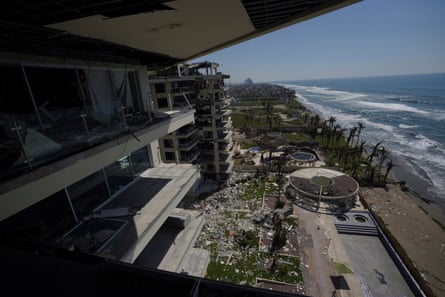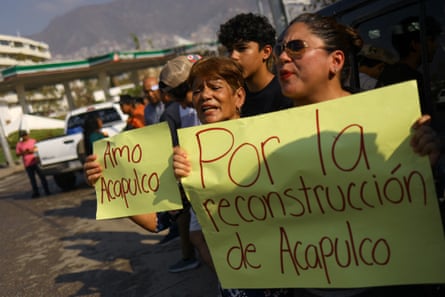After Hurricane Otis, there is a chance to rewrite Acapulco’s tale of two cities
On 25 October, Hurricane Otis, one of the strongest – if not the strongest – storms to hit Mexican harbours, devastated the beach city of Acapulco, leaving an official death toll of at least 48, with dozens more reported missing.
The degree of destruction of the city is unparalleled with that caused by other natural disasters in Mexico. At the moment, the future of Acapulco – once a playground for the international elite and now a place diminished by poor urban planning, corruption and violence – is an open question.
The state of Guerrero, where Acapulco is located, is perhaps the most complex entity in Mexico because of its challenging hilly geography, large and diverse Indigenous populations, high poverty levels and history of violence. Its mountains were the stronghold of Mexican guerrillas and the “dirty war” (marked by forced disappearances and torture against leftwing groups) during the second half of the 20th century, and today drug cartels in the region are some of the largest producers of the opium poppy worldwide.
During colonial times, the port of Acapulco was New Spain’s gateway to the Asia-Pacific. Over time, tourism became the city’s economic vocation. At least since the mid-20th century, the city has been one of Mexico’s landmark beach destinations and a hub for illicit activities, with one of the country’s highest crime and poverty rates. The city consistently ranks among the world’s 10 most violent and, according to official data, 16% of the population live in extreme poverty
In the 1970s, the journalist Ricardo Garibay portrayed Acapulco as a dichotomy, a contradiction – two cities that coexisted in the same place. Acapulco thrived during the jet age by constructing luxury homes in the rocky cliffs east and west of the harbour and developing high-rises along the Miguel Alemán promenade (named after the president who initiated the tourism development). Up in the mountains, the other city remained invisible; there was poor infrastructure and limited access to basic public services due to inadequate – or nonexistent – urban planning.
Public space became a private luxury. Access to prime beaches was mainly privatised by hotels and condos, leaving the less desirable locations for the local population. The two cities lived side by side without having to interact.

By the 1990s, newer developments such as Cancún by the Caribbean Sea or Cabo on the Pacific coast had replaced Acapulco for international tourism, but the development of a modern highway system attracted more visitors from Mexico City. At the dawn of the new millennium, Acapulco experienced a significant increase in crime and drug-related violence that descended from the mountains to the harbour.
after newsletter promotion
Nevertheless, Acapulco the beach resort continued to flourish, and well-off chilangos (Mexico City natives) moved from the harbour to newer developments in the Diamante zone in the western part of the city. Luxury Acapulco learned to live in a golden cage while the rest of the city experienced a spiral of violence.
A category 5 hurricane will inevitably cause major damages in any given place at any given time, but Acapulco was particularly unprepared for the storm. Despite the geographic protection of its mountainous terrain, the city lacked resilient infrastructure; irregular constructions prevail in the hills, building standards are inadequate for natural disasters, there is a low insurance culture and, overall, state capacity is extremely limited.
Now the reconstruction of the city offers a once-in-a-lifetime opportunity to correct the historical mistakes that have undermined Acapulco and Guerrero. The economist Luis de la Calle has underlined three core areas that must be prioritised: developing basic infrastructure (public spaces, logistics, energy, water); redesigning municipal governance and incentivising property tax collection and insurance; and promoting medical tourism for foreigners by harnessing Mexico’s world-class and relatively affordable private health services and the harbour’s natural attractiveness.
Ultimately, the reconstruction must focus on building a human-scale city and designing spaces for people. Reversing the privatisation of beaches would be a good starting point, as well as developing promenades and parks along the coast, with properly established retail space that generates revenue for its maintenance.

Likewise, high-rise developers could receive incentives to build social housing. Public-private partnerships offer an alternative way to rebuild damaged infrastructure without having a large impact on public finances.
Decades of social and political conflict, violence and military presence have held back the development of Guerrero. For years, commentators have issued death certificates for Acapulco, but the city has proved to be resilient. The destruction caused by Otis will be no exception. The real question is if the reconstruction will finally be able to bridge the gap between the two Acapulcos.